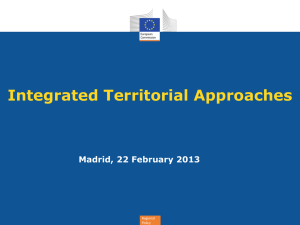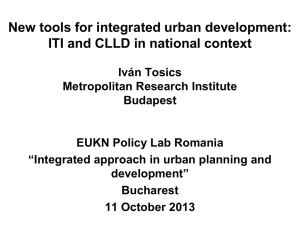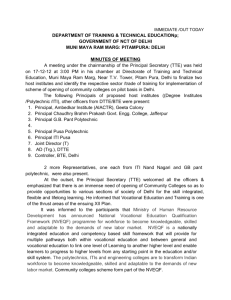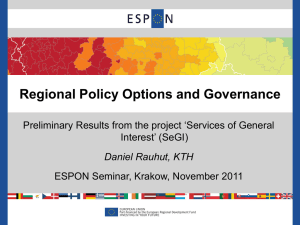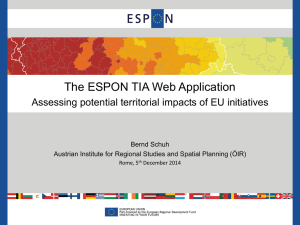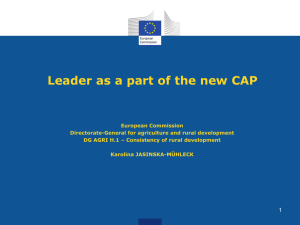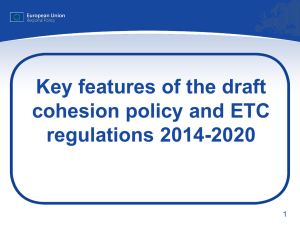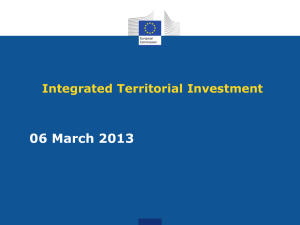ITI
advertisement
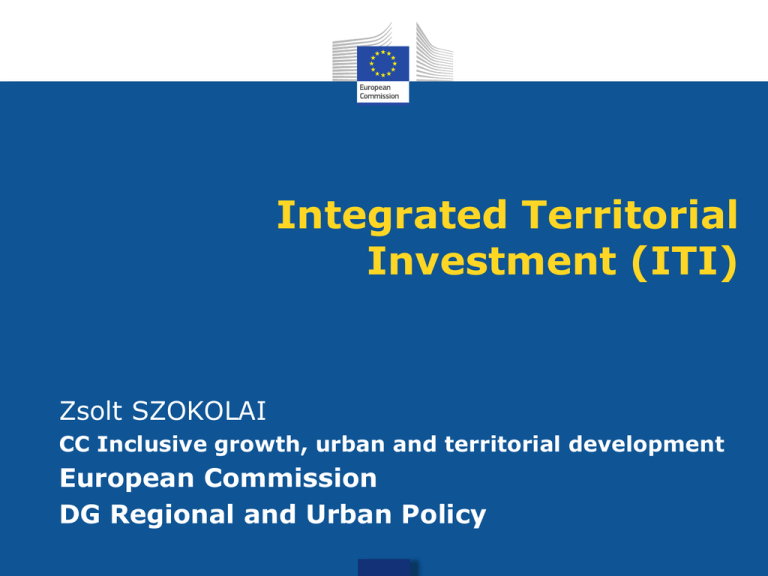
Integrated Territorial Investment (ITI) Zsolt SZOKOLAI CC Inclusive growth, urban and territorial development European Commission DG Regional and Urban Policy Urban (and area-based) development • Integrated • with a global and comprehensive vision of the city • taking into account the need to improve the economic performance, the eco-efficiency and social cohesion of the city • assuring citizens’ quality of life and welfare in all the existing communities and neighbourhoods of the city • Participative • involvement in urban development through citizen participation • URBAN ex-post: successful projects are the participative ones • Inclusive • Reduce social polarisation by paying special attention to deprived neighbourhoods within the context of the city as a whole • ‘Integrated’ also refers to ‘inclusive’: inclusive shared project of coexistence, to combat social exclusion and spatial segregation Reinforced urban dimension of the Cohesion policy • "Cities should be in the heart of the debate" – Cannot achieve our goals without cities • Increase role of cities in the delivery of our policy objectives • Involve in programming and implementation Proposing tools for sustainable territorial development • • • • Need for addressing territorial challenges We offer flexible tool to facilitate integrated approach Thematic objectives – linked to Europe 2020 Priority axes: correspond to one or more investment priorities of a thematic objective Integrated sustainable urban development strategies Setting out integrated actions to tackle • • • • • Economic Environmental Climate Social Demographic challenges (EP position) Article 7 ERDF Implementation tools for integrated actions for SUD strategies • Multifund OP (priority axes funded by different funds) • New territorial tools to implement integrated strategies • ITI, CLLD, Multi-objective priority axes • URBACT: capacity building to improve performance on CP implementation • Urban Development Platform: dialogue on the use of new territorial instruments • Urban Innovative Actions: try new ideas Urban and territorial dimension of the future CP Minimum 5% of ERDF for integrated urban development with Urban authorities responsible for implementation Thematic objectives, (Urban) investment priorities Multiobjective priority axis ITI Cross-border and interregional cooperation Community-led local development OP URBACT Urban development platform Urban innovative actions (0,2% of ERDF at EU level) Sustainable urban development – 5% is just the minimum At least 5% of ERDF under Investment for jobs and growth goal for SUD with Urban authorities responsible for implementation (at least selection of operations) May be implemented through an operational programme through multi-objective priority axes through ITI 5% is linked to the involvement of cities, not to the use of one particular implementation tool No direct relations between the content of ITI and the urbanspecific priorities Urban and inclusive investment priorities of ERDF • 4(c) supporting energy efficiency and renewable energy use in public infrastructures and in the housing sector; • 7(c) promoting sustainable urban mobility • 8(b) local development initiatives and aid for structures providing neighbourhood services to create new jobs • 9(b) support for physical and economic regeneration of deprived urban and rural communities; • 11 enhancing institutional capacity and an efficient public administration ITI – how does it work? ITI is an implementation tool of an urban development strategy or other territorial strategy or pact, which requires integrated approach – Ex-Article 99(1) CPR Bundle funding from different priority axes and programmes (ERDF, ESF, CF), may be complemented with financial support from EAFRD and EMFF For a functional area at the appropriate territorial scale More than one priority axis of one or more OPs MA may designate one or more intermediate bodies to carry out the management and implementation of an ITI ITI – what are the advantages? ITI secures various funding streams at its inception – allow a greater degree of certainty and predictability for implementation Selection of operations: not nesessarily competitive (calls for proposals), can be negotiated programming Potential synergies (using different funds in a timely, strategic way) may lead to better aggregate outcome Delegation of management has the potential to empower the sub-regional actors by insuring their involvement from the beginning of the programme Increased ownership of strategy and actions ITI – interventions Intervention logic – Matrix of territorial and thematic objectives Interventions under ITI should contribute to the objectives of the corresponding investment priorities and to the objectives of the territorial strategy Scope What for? instead of What? Determined by the territorial strategy and the investment priorities of the priority axes contributing to ITI Forms of support Can be grant, FI. CLLD can part of it ITI is to implement (tipically parts of a) territorial strategy with Vision Describe the elements of the intended territorial change Strategy Based on the development needs of the territory Logical link between planned operation and intended change Identify corresponding thematic priorities for each operation Coherent and cohesive with the synergies between planned actions considered and presented Result indicator related to main territorial objective of strategy Implementation arrangements, including possible delegation If appropriate, assessment of capacity for implementation ITI –coherence with programmes Territorial strategy should be coherent With the integrated approach to territorial development of the PA With the territorial approach of the programme (or programmes) Critical size: Appropriate investment priorities (based on development needs of the territory) and proportionate financial allocation Ensuring an appropriate governance arrangement When to use ITI? There is an integrated territorial strategy Territorial strategy can have thematic focus (e.g. Urban mobility plan) Complex sectoral policy: design the priority axis accordingly OP divided on sub-regional level: in principle possible. Functional territory? Implementation requires integrated investments from more than one priority axes (or operational programmes) Can ensure that number of priorities and resources allocated to an ITI are proportionate and reflect to the need of the territory Do not define contributing priority axes uniformly on national or regional level Management arrangements allows simple implementation structure Preferably single management organisation (IB) responsible for implementation Sustainable urban development and ITI Example: Member State A Regional ERDF-ESF OP Intermediary body I T I National/sectoral ERDF OP ESF OP CF OP Possible implementation arrangements for multi-OP ITI • MS designate an IB for management and implementation of an ITI • Define investment priorities of priority axes of OPs contributing to the ITI • Agreed compliance and eligibility rules adopted by each MC of participating OPs • Joint Monitoring Sub-Committee with relevant OPs • Common monitoring and evaluation, progress report • Financial management: monitoring system for the programmes provides for the identification of operations of a priority axis • COM role in assessment of performance: progress report? Programming – Why should cities follow the process? Partnership Agreement sets out Analysis of disparities, development needs, growth potentials with reference to thematic objectives and territorial challenges – Article 14(1)(a)(i) CPR Integrated approach to territorial development – Article 14(2)(a) CPR Arrangement to ensure an integrated approach to the use of CSF Funds for the territorial development, in particular the implementation arrangements for ITI, CLLD – Article 14(a)(ii) CPR Programming – OP to describe Art 87(3) Integrated approach to territorial development, having regard the PA, showing how the integrated approach contributes to the accomplishment of the programme objectives, specifying: the principles for identifying the cities where integrated actions for SUD will be implemented indicative annual allocation of ERDF support including the resources delegated to cities for management under Art 7(2) ERDF [OP, ITI, multi-objective priority axes] indicative allocation of ESF support Approach to the use of ITI outside urban, and their indicative financial allocation from each priority axis Implementation arrangements ITI in ETC • Art 10 ETC: the intermediate body to carry out the management and implementation of an ITI shall be an EGTC or other legal body established under the laws of one of the participating countries • ITI creates the possibility to combine actions financed from different strands of ETC and mainstream programmes • Relevant to cross-border and trans-national programmes Relation between ITI and CLLD Territorial strategy to be implemented through ITI can have CLLD as one component of the strategy If within an ITI, consistency to be ensured (eg. urban strategy ITI + specific urban neighbourhood targeting through CLLD partnership approach) Having a CLLD within ITI is not granted: CLLD should always go through the selection procedure as required in Art 29(3)–(5) CPR and described in the PA and OPs ITI CLLD Urban development strategy or other territorial strategy or pact Sub-regional (10000 – 150000 inh. - except duly justified cases) Requires an integrated approach Integrated & multi-sectoral, area based, partnership approach Involving investments from ERDF, ESF, CF, may be complemented by EAFRD, EMFF ERDF, ESF, EAFRD, EMFF can all support joint strategy Implementation tool to deliver integrated strategy Strategy & implementation by local action group Top-down, public sector-led Bottom-up, community-led (public, private, civil society) Selection of target areas not necessarily competitive Optional MS define selection criteria, selection by responsible MA(s) Optional (except for EAFRD) Useful links • Fact sheet on ITI: http://ec.europa.eu/regional_policy/what/future/proposals_2014_20 20_en.cfm • Guide to Ex-ante evaluation http://ec.europa.eu/regional_policy/sources/docoffic/2014/working/ex_ante_en .pdf • SAWP documents and presidency compromise texts Thank you very much for your time and your attention! Zsolt.SZOKOLAI@ec.europa.eu +32 229 65 288
